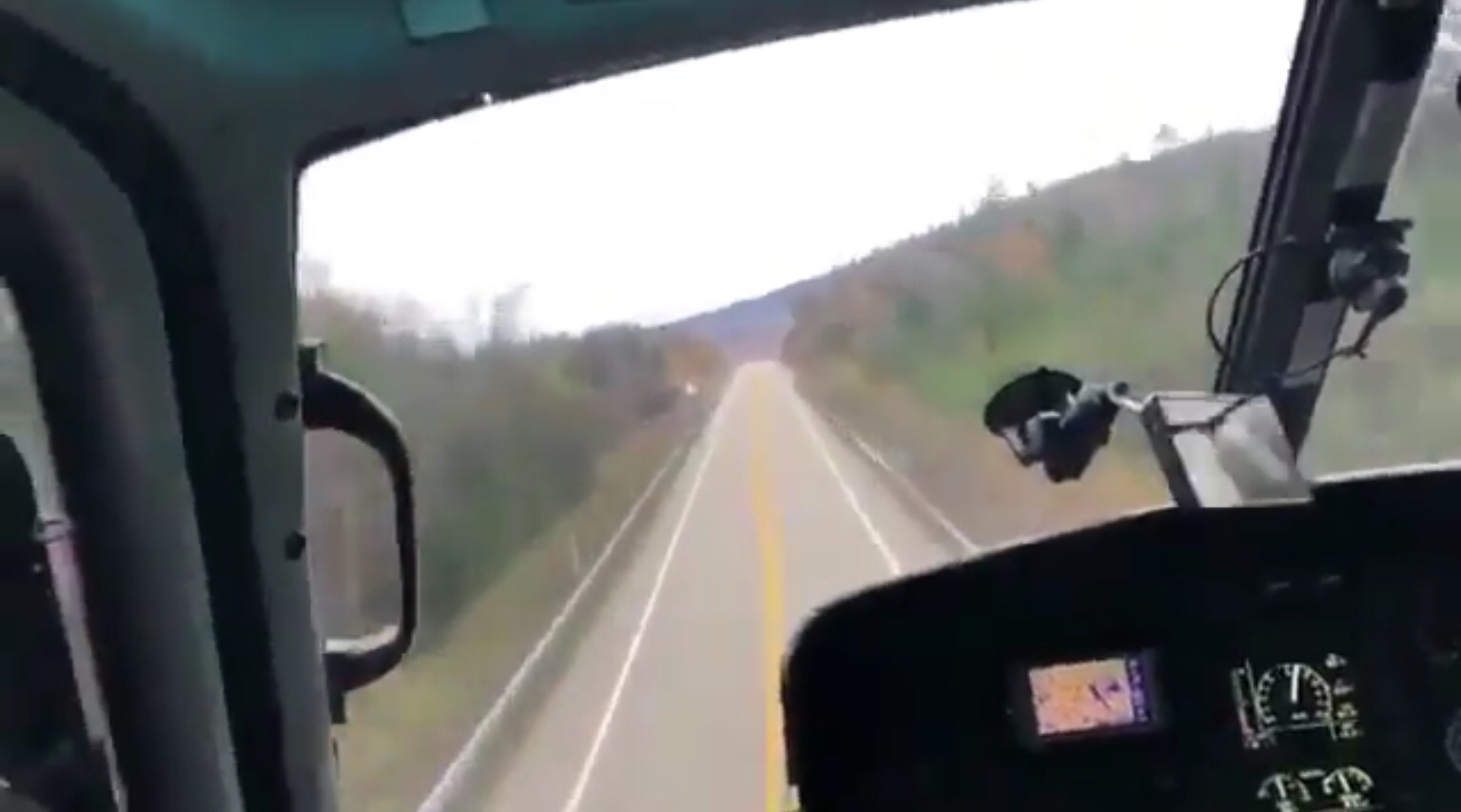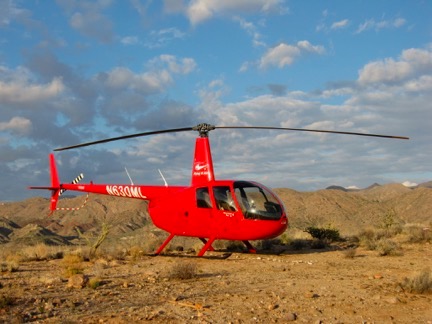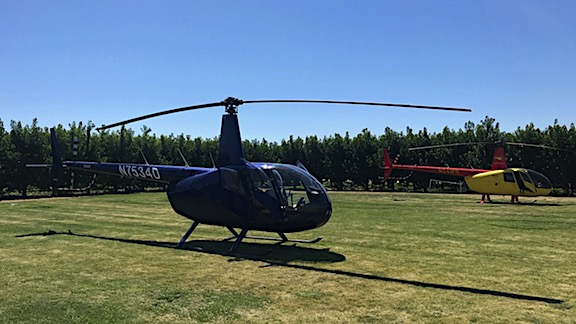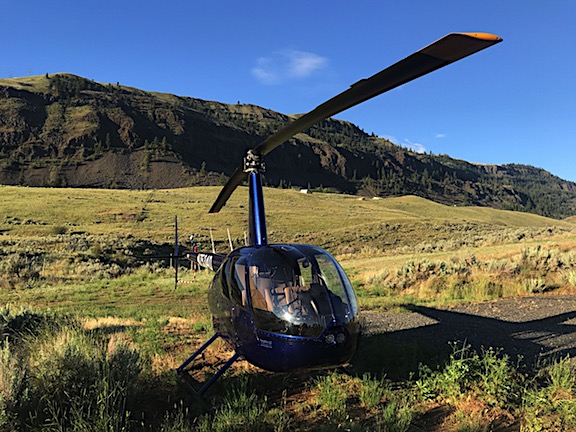I fly to my helicopter to the boat show in Anacortes, see a bunch of boats, get tempting special show pricing, and fly home.
(Continued from previous post)
My goal was to be in the air by 8 AM so I’d arrive at Anacortes Airport with plenty of time to get to the Boat Show when it opened. I assumed it would take me all day to see the boats that interested me and was worried that exhibitors would start packing up early since it was the last day of the show.
Weather Woes
But the weather did not cooperate. Overnight, the local forecast had changed. Now it wasn’t expected to clear up until after 11 AM. I don’t need clear skies to fly, but I do need ceilings (cloud bottom heights) above the pass where I expected to cross the Cascades. As I went about my morning routine, the clouds seemed to drop in the west and rain began.

The view from my deck at 6:34 AM. My route would take me right through the middle of this photo.
I continued my morning routine, but without the same sense of urgency. I showered and dressed in clean jeans and a shirt that suggested it wasn’t out of the question that I might spend nearly a quarter million dollars on a boat. Then Penny and I headed down to Pybus Market, where I’d left my tables and display stuff. I was supposed to be selling my jewelry there that day and had already paid for my spot. But with sales so bad the previous day, I didn’t have high hopes for a good day and didn’t mind eating the fee to do something more interesting with my time. I packed everything up and loaded it into the back of my truck.
Back at the helicopter, I took my time setting up my GoPro, preflighting, adding oil, and settling Penny in the front passenger seat. The rain had passed and it was clearing a little. I used a microfiber cloth to dry the helicopter, which also took any dust off. By the time I was ready to head over to the airport for fuel, it was nearly 10 AM. The weather still looked iffy.
My friend Rich, who bought my friend Jim’s old R44 Raven I, was doing pattern work when I radioed my approach. He landed beside me as the fuel guys were topping off my tanks. I told him where I was headed and that I hoped to get over the ridge at the headwaters of Icicle Creek. I’d discovered on a flight to Lopez Island years ago that that particular ridge is adjacent to Stevens Pass on a more direct line from Wenatchee. If the ridge was clear of clouds and I could cross it, there was a good chance that I could drop into the valley beyond and follow Route 2 due west toward the coast. We chatted about other things and then parted company.
It was just after 10 when I did my walkaround, climbed back on board with Penny, and got my GoPro running. Mounted via suction cup over the front passenger seat, it was connected to a battery power pack and the helicopter’s intercom system. It would shoot continuous video as well as a still image every 60 seconds.
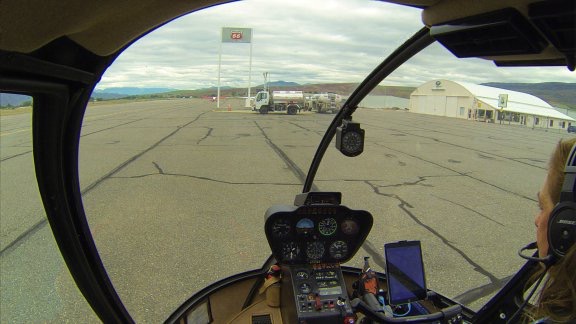
Here’s the GoPro’s view just before departure from Pangborn Memorial Airport. As you can see, the weather does not look promising.
Nothing ventured, nothing gained. I took off, heading northwest.
The Flight to Anacortes
One of the benefits of flying a helicopter is that there is no minimum airspeed. This makes it extremely suitable for flying in conditions where it might be necessary to slow down or make a very tight 180° turn. As I flew northwest toward the mouth of the canyon at Icicle Creek near Leavenworth, I was mentally prepared to make a turn if low clouds obscured the mountains and made it impossible for me to cross the mountains.
And it sure looked like it would be necessary as I got closer and closer to the ridge. The clouds were sitting atop the Enchantments — that’s the mountains just west of Leavenworth. I was in a relatively narrow canyon with the creek below me and cloud covered mountains on either side. If I couldn’t go forward, I’d have to stop, turn around, and go back.
Of course, you can’t see the end of the canyon from halfway down it. So although it looked very bad at one point, when I rounded a bend, it didn’t look so bad after all. Then bad, round a bend, and not bad. I was at least 1,000 feet off the creek and climbing with the terrain. I never reached the level of the clouds.
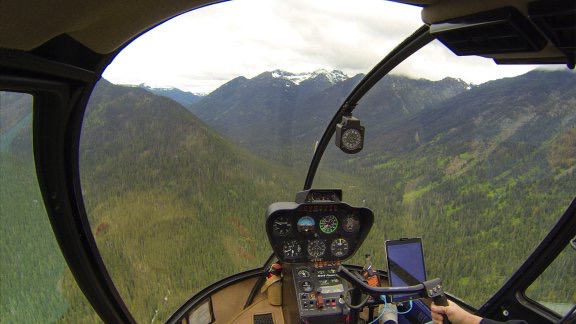
This is one of the points where it looked iffy. But when I rounded that bend, it looked much better.
Then the ground came up to a ridge with plenty of space between the treetops and the cloud bottoms. I steered over it and saw Route 2 winding down the west side of Stevens Pass. Just like that, I was over the Cascades. I didn’t even have to slow down.
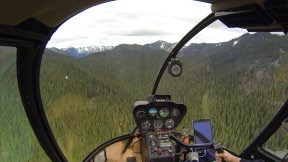

These photos, taken 1 minute apart, show me approaching the ridge at the headwaters of Icicle Creek (left)and then topping the ridge where I can see Route 2 coming down the west side of Stevens Pass (right).
I descended down into the valley and followed Route 2 almost due west to Skykomish, then headed northwest toward Anacortes. The canyon opened up and the terrain dropped around me to mere hills. I flew along at a cruise speed between 100 and 110 knots, over creeks and marshes and forests, past logged terrain and waterfalls and quarries. The wind was still calm and the ride was smooth. Penny occasionally stirred in her seat or sat up as if to ask “Are we there yet?”

I crossed over a lot of wooded, hilly, and logged terrain between Skykomish and the coast.
I tuned into various nearby airport frequencies as I flew. I got close enough to Arlington and Skagit to make radio calls, but didn’t fly over either one.
Eventually, I left the mountains and hillsides behind, crossed I-5, and flew over the flat farmland along the shoreline. As I flew over various waterways, I wondered whether a boat with a 30-inch draft could navigate them. (Yeah, my boat lust had gotten that bad.)

This was shot somewhere west of Mount Vernon.
Then I was over Fidalgo Island, climbing over one last hill before looking for the airport. I found it very close to the hillside and came in for a landing on the parallel taxiway. I set down in an airplane parking spot near the fuel island, wondering whether the hose would be long enough to reach me where I was parked. I didn’t see a fuel truck.
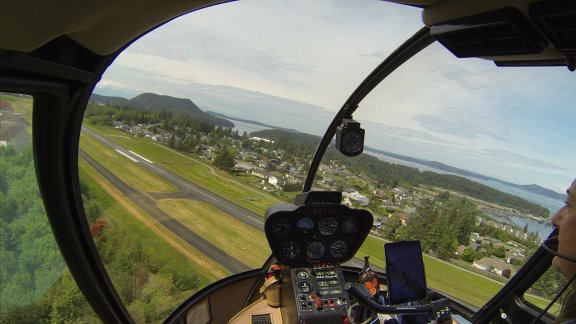
Making the turn for landing at Anacortes.
I shut everything down and let Penny out while I gathered everything I’d need for the day. Then, after a quick bathroom visit in the Pilot Lounge, I used Uber to call for a ride. We were on our way to the Marina five minutes later.
At the Boat Show
Andrew at Ranger Tugs had put tickets aside for me at the Will Call office, so that where I started. The event isn’t expensive — only $10/person — but I think they charge a fee to discourage low-budget lookie Lous. Let’s face it: the Anacortes Boat & Yacht Show has the word “yacht” in it for a reason. The majority of boats on display were far beyond the means of 99% of the people who attended.

A look to the right from the ramp leading down to the boats for sale.
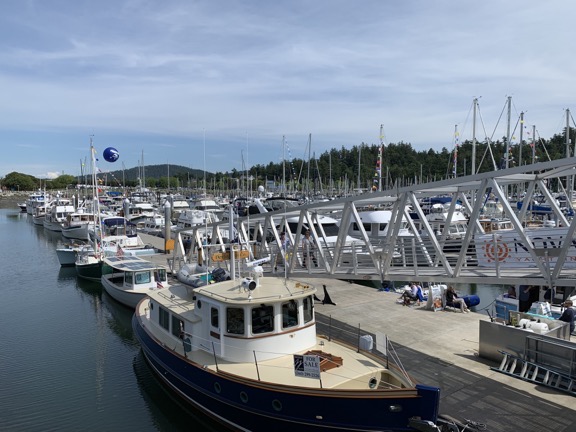
A look to the left at the boats for sale.
I didn’t waste my time looking at boats I couldn’t afford, although I do admit looking at a few that didn’t quite fit my needs. In most cases, the problem was towing: I needed a boat I could easily tow from home to anywhere I wanted to launch it, whether that was 12 miles from home at the boat ramp behind Pybus Market or 1200 miles from home in Arizona’s Lake Pleasant. That meant it could be no wider than 8-1/2 feet, which is the legal limit for normal trailer loads. Wider than that and I’d need a special permit to tow it and would have to get Wide Load signage and possibly a pilot car. The Cutwater boats seemed to fall into this category. Other boats were lacking in the livability department and wouldn’t be comfortable for more than a few days. Some were inboard motors and I preferred an outboard. None of them had the finely honed feature set the R-27 Ranger Tug I lusted for had.
I should mention here that “looking” at a boat didn’t mean looking at it from the dock. It meant climbing on board, and looking from the stern of a boat. All the boats had ramps leading to them so it was an easy deal. In most cases I either left Penny tied up on the dock or I picked her up and brought her on board. Although it would have been quite a treat to explore the giant yachts parked here and there along the dock, there was no reason to make me want something I couldn’t afford. It was best to stick to the program and let the lookie Lous have their fun without me.
I spoke to a sales guy at the Ranger Tugs area where their five models — R-23, R-27, R29, R31, and R41 — were parked. He gave me a sales spiel that included favorable pricing on the R-27 parked there. Prices go up by $10K in July for the 2020 model year, he warned. This was the last boat off the line for the 2019 model year. I checked out the smaller R-22, which I think would be too small for me. I asked questions about the windlass — cruising on the David B had convinced me that I would be unable to pull up an anchor, especially if it had 50 feet of chain and another 100 feet of rode set out. Andrew walked up and I chatted with him about it. He gave me even better pricing. We talked about desalination and dingy storage.
Later, I walked around the marina to look at some used boats on the far end. There was a 2016 Ranger Tug for sale there at the same price as the deal Andrew offered. Jeez. Was it wishful thinking on the part of the owner/broker or did the boats really hold their value that much? Why would anyone buy a used 2016 model when a brand new 2019 model, with all its improvements, from the factory could be had for the same price?
Penny and I left the docks and walked up to where other exhibitors were gathered inside a big tent or outside under smaller canopies. I got into a conversation with a boat broker about her upcoming trip to Ketchikan on her 41 foot Nordic Tug and my recent one on the David B. Her husband joined us and we talked about financing, which I hadn’t even considered. Even though they knew I wasn’t going to buy a boat from them, they were every helpful. And they seemed impressed that I was considering an R-27; the woman said it was an excellent option for me.
I looked on as a sales guy explained a desalination system to a couple. The system was very large and convoluted — not to mention expensive — and I wandered off.
I chatted with two sales guys about a Zodiac boat to use as a tender for an R-27. Andrew had recommended them because they’re relatively light weight. Apparently they come in sizes as small as 6 feet (inside length), although they said the next size up might be better for me. One guy even described how he gets his Zodiac out of the water and stowed on his boat by himself. They seemed confident that I could handle it alone.
I had wanted to look at Bayliners — Captain Jeffrey on the David B mentioned that they had models similar to the tugs I liked — but they were not at the marina. They were in a boatyard who knows where. This morning, as I started researching links for this blog post series, I looked them up. Although they may have had boats like a tug in the past, their current lineup did not include anything remotely similar. So I’m glad I didn’t track them down. It likely would have been a waste of time.
Since I hadn’t had a thing to eat all day, I decided to have lunch before heading out. Fortunately, between the marina entrance and Anthony’s Restaurant, there was a casual dining place called the Cabana. Penny and I walked right through and I got a seat on an Adirondack style chair in the shade of an umbrella — did I mention that the weather was sunny and warm? — overlooking an unused bocce court and the marina. A short while later, I was digging into a blackened rock fish taco while Penny was stretched out in the sun for a nap.
I had a lot to think about. Too much. It was strange to me, almost as if the stars and planets were aligning for me to buy this boat. There’s no doubt that I loved it and that it met all of my needs and most of my desires. (I’ll be honest a much larger boat that came with a bunch of guys to move it around for me would be a lot more attractive but definitely not in my budget.) I knew that I’d be happy with it, perhaps for a very long time. Who knows? It — or something a lot like it — could be my next home.
But I won’t kid you: there are financial hurdles to jump. Selling the helicopter would make the boat easily affordable without any financing, but was I ready to retire from flying? Could I get a seasonal job flying for someone else? Did I really want to sell the helicopter? I’d been an owner for nearly 20 years and I honestly couldn’t imagine life without one.
But could I have both? Did I want the financial burden that came with owning both? The answer to that is no.
Meanwhile, as I sat in the shade at the Cabana, I realized that clouds were building in the mountains to the east. Was I going to have trouble getting home? Time to find out.
The Flight Home
Time for a shameless plug…
If you like helicopters, you’ll love the FlyingMAir YouTube Channel. Check it out for everything from time-lapse annual inspections to cockpit POV autorotation practice to a flight home from a taco dinner at a friend’s house — and more.
Getting an Uber back to the airport wasn’t quite as quick as I’d hoped. The closest car was 25 minutes away. I tried Lyft, but they didn’t have anyone at all. So I parked myself on a bench near the entrance to the show and waited. Penny found shade under the bench and took another nap.
Back at the helicopter, I decided I had enough fuel to get me home with required reserves. So I just started up — with some trouble, which will be covered in a future post — and took off.
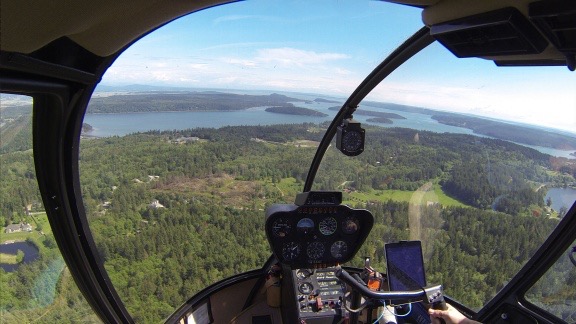
Flying down the west side of Fildalgo Island.

The clouds were low as I approached the canyon where Route 2 wound up toward Stevens Pass.
The conditions started off nice — after all, it was a really great day out near the San Juan Islands — and then got very iffy. The cloud level in the foothills to the Cascades had definitely dropped since I’d come through that morning. Some of the cloud tops were obscured. A gusty wind was blowing out of the south, setting me up for mechanical turbulence — turbulence caused by the motion of wind over landforms. It began raining lightly.
For a while, I was worried about the flight. Because I hadn’t taken on more fuel at Anacortes, I didn’t have enough on board to do detour around weather looking for a clear passage to the other side. (Yes, I did have enough to get home with required reserves.) That meant that if I hit a dead end on my course, I’d have to go back, probably to Arlington, to get more fuel before trying again. Conditions were likely to get worse before they got better, so going back might even mean spending the night, which I really didn’t want to do.
(They say that the only time you have too much fuel on board is when you’re on fire. It’s always better to have more fuel on board than you need — unless it puts the aircraft weight over limitations. It gives you more flexibility.)
As for the weather, now you can see why I fly to the Seattle side of the mountains so seldom.
Once I got to Skykomish again, however, the rain stopped and the clouds lifted a bit. I was even sheltered from that gusty wind. I reached the ridge near Stevens Pass, climbed up, and hopped over it, down into the Icicle Creek Canyon where it was a beautiful day full of sun and big fluffy clouds.
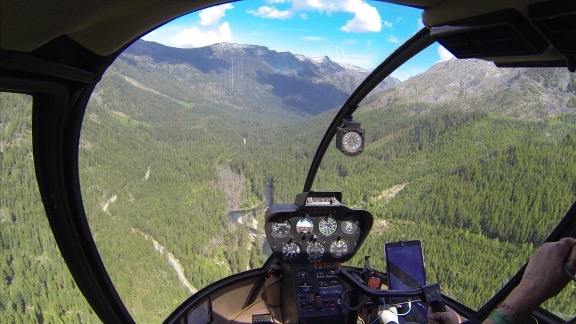
It was a typically beautiful day on the east side of the mountains as I flew down Icicle Creek.
The rest of the flight was great and I even took a moment to record a little in-flight lecture about what it’s like to be a helicopter pilot and owner. I recently discovered that has far more subscribers than I thought and I’m now motivated to add new content there regularly.
I was back at my base by 5 PM. I spent the rest of the day gardening and doing chores around the house.
If I had driven, I’d be starting my return trip around 6 get back in the dark.

